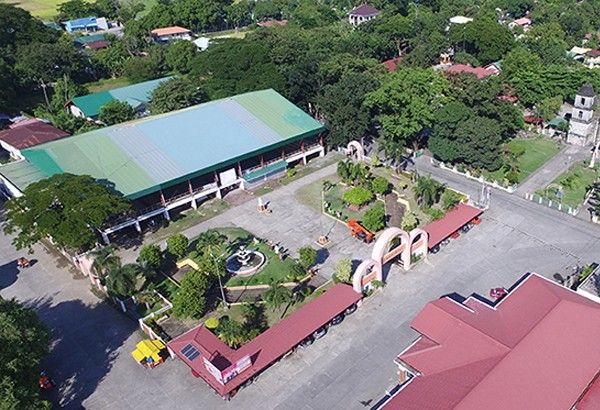Beautiful Bacnotan


This week we pick up once again with our series on Philippine plazas and parks. I found myself in La Union last month for a series of meetings — a day trip with little opportunity to see the sights. I managed, however, to drive into a town that hid a jewel of a church, a generous plaza, and picturesque surroundings.
Bacnotan is a few minutes north of San Fernando, the capital of La Union. It is one of the key towns of the northern part of the province and today it is best known for its extensive limestone deposits. The limestone feeds a large cement production facility, which started only in 1949. Originally established as Cebu Portland Cement, the plant changed hands and renamed into Bacnotan Consolidated Industries a decade later. In 2004, it was sold to Holcim Philippines, which runs it to this day.
The limestone quarries and the cement plant are in the north of the town, unseen by most visitors who ply the national highway that leads up to the Ilocos provinces. It was while travelling on this road that the Bacnotan town church caught my eye as we sped by. This was because the church’s façade is a terminus of kilometer-long main street that leads inland from the main junction. As the town has not urbanized much compared to San Fernando, the town’s main landmark was and still is its church and twin bell towers; clearly visible since no other tall structure in the townscape compromises its physical primacy.
I took a detour from my journey to visit the center of the town and discovered a classic church and plaza composition that is fairly well conserved. I also noted that this core is surrounded by a classic grid of streets creating blocks of a third of a hectare in area. The town’s core, defined by this grid, covers 11 hectares. This appears to be the average size of provincial towns. Beyond this gridded morphology, the town reverts into an agricultural landscape reaching to its boundaries and to the sea on its western edge.
Bacnotan was founded as a town in the late 16th century. It was, at turns, part of Ilocos Sur and Pangasinan until it became one of the original 12 towns that formed the province of La Union in 1850. The town figured in key battles in the Spanish-American and Second World Wars. After WWII, the town served as the provisional seat of the provincial government until San Fernando, which was heavily damaged in the war, was rebuilt.
This role led to the town’s development along with the establishment of secondary and tertiary educational institutions. From the 1960s, the town grew slowly, mainly on the impetus provided by cement production. In the last few decades, progress has visited the town with infrastructure projects like the Bussaoit Water Impounding Project, a Sow Breeding Project in Baroro, and the Agro-Forestry Complex donated by the Japanese government. This has led to Bacnotan’s standing as a first-class municipality currently composed of 47 barangays.
The center of the town is defined by an open space, its plaza, which is about 7,000 sqm. in area. With the church’s parvis (forecourt) of about 2,000 sqm., the total area accessible to the public is about a hectare. This is about the norm for most town plazas in the region.
The church and municipal hall define two sides of the space. Bacnotan’s church is named after the town’s patron, Saint Michael the Archangel. The first church was built in the early 1600s. A more permanent structure was built by Fr. Juan Zugasti and completed in 1819. The church was ruined by a temblor in 1860, and restored in 1887.
The church was designed in the traditional Philippine baroque style with some neoclassic touches. The façade is flanked by two three-tiered bell towers. The towers appear to have been rebuilt after the war with some elements in reinforced concrete. It is filled in with the original stone but the original plastering is gone. This protective plastering is also missing in the main façade leading to vegetation growing in spots. This is dangerous as the presence of vegetation says that the structure is infiltrated by moisture and thus its structural integrity is compromised.
The original bells with the date Nov. 20, 1874 inscribed in them is displayed in a kiosk nearby. Two other additions to the church are seen in a concrete canopy over the main entrance portal and in a tower built over the driveway, specifically for the salubong ritual on Easter Sunday.
The municipal structure is a new construction, probably built over the Spanish or American-era structure. Its style is typical of many town civic structures in the Philippines today.
The plaza itself is split into two areas. The first is an open, mostly paved section directly across the municipal hall. It has the requisite statue of Dr. Jose Rizal. Behind it is the other section, a roofed multi-purpose hall, which is now de rigueur with most Philippine towns and cities.
In the 1990s, the plaza was renovated by the town’s government with the assistance of the DOT and the local congressman. It seems to have undergone additional renovations since, with the addition of a squad of super heroes and animation characters sharing the space with Dr. Rizal.
The town’s core contains some heritage structures of some interest. The ambiance of the town is characterized mostly by the agricultural landscapes that surround it. Urbanization has thankfully been contained along the national highway, thus conserving most of the town’s quiet and slow-paced mien.
I score the Bacnotan’s plaza an 8 out of 10 and I look forward to visiting the region again soon to discover other plazas, which escape the attention of most of us.
* * *
Feedback is welcome. Please email the writer at paulo.alcazaren@gmail.com.



















